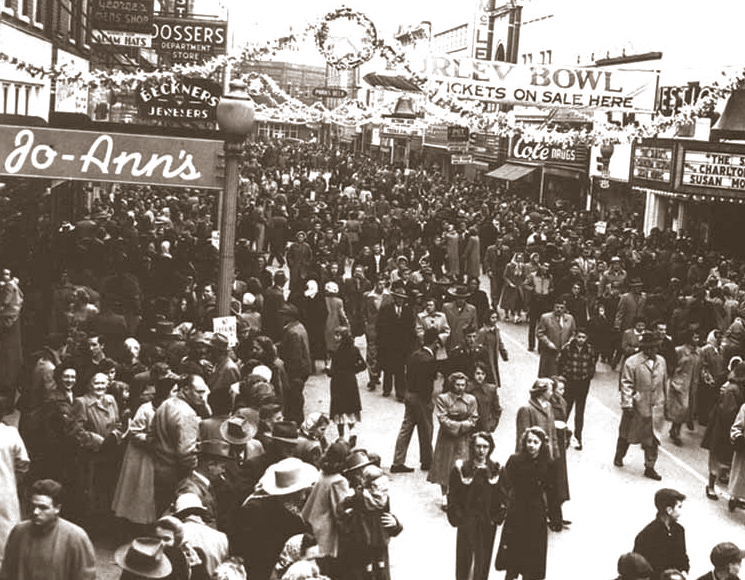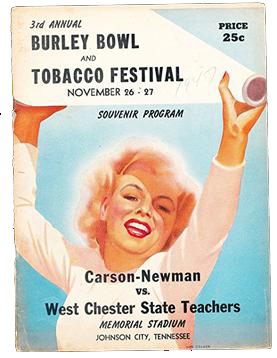
By Trey Williams
It might have ended up in the ash heap of history, but the Burley Bowl burned brightly for a number of years after World War II.
The Thanksgiving Day bowl game at Roosevelt Memorial Stadium occurred annually 12 straight years (1945-56), drawing everyone from governors of Tennessee and the mayor of Hammond, Louisiana to 1921 Penn State All-American Glenn Killinger.
The bowl was part of a two-day tobacco festival. Festivities included postgame banquets and dances for the players at locales such as the John Sevier Hotel and the Johnson City Country Club. The festival kicked off with a Thanksgiving morning parade.
Dickie Warren, 88, had a Hall of Fame career coaching basketball at Sullivan Central. But he played football at East Tennessee State, and fondly recalls spending Thanksgiving defeating Emory & Henry in 1953 and shutting out Appalachian State ’55.
“It was a time when it was a special game for East Tennessee State and the city of Johnson City,” Warren said Sunday night while thankful for a visit from his granddaughter Jenna Hare, a scoring machine for the Sullivan East basketball team. “And when we won those games, that made things even better. I played pretty well, I think. I wasn’t the hero.
“Of course, the crowd was outstanding. Nothing like that had happened around here at that time. It was a fun thing. It was neat.”
Warren’s teammates included Hal Morrison, who became ETSU’s first All-American in 1953. Morrison caught 20 TD passes in an era when many coaches loathed the forward pass. Morrison also played basketball and baseball.
“Hal Morrison was an outstanding football player, but a better person,” Warren said. “He was outstanding at East Tennessee State. He was a good friend.”
Another teammate of Warren’s was colorful Don Riley, who went on to be ETSU’s head coach and was a source of inspiration for the Luther character on “Coach” played by Jerry Van Dyke.
“Don Riley was a little squirt, as we all called him,” Warren said with a chuckle. “But he could play. He played quarterback most of the time for us. He could throw the ball well and played well.
“What a precious memory Don Riley is. He was a good one.”
Warren played for Star Wood at ETSU.
“He was the best,” Warren said. “When you needed it he got after you. But he also congratulated you and thanked you and appreciated you and accepted you. He wasn’t one of those fighter type coaches. He was just a smooth, easygoing guy who got it done.”
The Burley Bowl’s novelty seemed to wear off the final few years after the post-war buzz. Frigid temperatures and predictable matchups the final few years didn’t help, either. And more bowls were sprouting up every year.
But a great many area sports fans were thankful for the Burley Bowl for the first 8-9 years. Billy Gene Williams became a legend at Langston High School and started at quarterback as a freshman for Dillard University in New Orleans.
His dreams of playing college football took root watching Burley Bowl games he’d snuck in to see.
“It was exciting,” Williams said. “Seemed like it was always cold, but I liked to watch those games.”

1945 – High Point 7, Milligan College 7
Johnson City celebrated its first postwar Thanksgiving in grand style. Thousands endured wind and sleet to watch the parade kicking off the two-day festival.
Disabled World War II veterans were seated on a specially constructed platform at field level on the west side of Roosevelt Memorial Stadium. The game was played in a mix of rain and snow after two days of rain muddied the field.
1946 – Southeastern Louisiana 21, Milligan College 13
Southeastern Louisiana had to come from behind twice to overcome Ray Brown’s Thundering Herd.
The Buffaloes’ Lynn Goddard returned a punt 85 yards for the game’s first score. Milligan’s team included Bill Showalter, the father of New York Mets manager Buck Showalter. The Buffs had quarterback Claude Holsclaw and back Duard Walker, who returned an interception 65 yards to the Louisiana 15.
The Lions returned to Roosevelt Memorial Stadium to play the Buffs in the regular season (Sept. 13) the following year, and played to a 6-6 tie in front of an estimated 7,000 fans in what the Elizabethton Star described as a “jam-packed” stadium.
1947 – West Chester State 20, Carson-Newman 6
West Chester State (9-0) took on Carson-Newman (8-0-2) in a battle of unbeatens. West Chester State was in its 11th season under Glenn Killinger, an All-American at Penn State in 1921. An estimated 10,000 was in attendance.
1948 – West Chester State 7, Appalachian State 2
The Mountaineers, led by Herman Bryson, took a 2-0 lead in the first half one play after a punt from Maryville alum Bill Cross started the Rams at their 2-yard line. Bryson was an All-American and drafted by the New York Giants. Attendance was estimated at 12,000.
1949 – Emory & Henry 32, Hanover 0
The running and passing of Bob Miller and talented Jesse James led Coach Conley Snidow’s Wasps to their 10th straight win in front of an estimated crowd of 12,000. Emory & Henry traveled well enough to help land a return trip.
1950 – Emory & Henry 26, Appalachian State 6
Miller scored and broke his own Virginia scoring record with 114 points on the season as the Wasps repeated. The crowd was again estimated at 12,000.
1951 – Morris Harvey 27, Lebanon Valley 20
The victorious Golden Eagles were from Charleston, West Virginia. Lebanon Valley traveled from Anville, Pennsylvania. An estimated 9,000 fans attended, including Governor Gordon Browning. The event included what was reportedly the biggest parade to date.
1952 – East Tennessee State 34, Emory & Henry 16
Jerry Ford scored two touchdowns and All-Conference player Art DeFillipo delighted the majority of the estimated crowd of 10,000 with his defense.
1953 – East Tennessee State 48, Emory & Henry 12
Ed Foster scored two touchdowns and Little All-American Hal Morrison, Buddy Saulsburg, Don Riley, Jerry Ford and Joe Davis also found the end zone in the regional romp. DickieWarren had an interception. The temperature was in the 30s.
1954 – Appalachian State 28, East Tennessee State 13
Jim Ollis rushed for 108 yards and two touchdowns as Coach E.C. Duggins’ Mountaineers recorded their first Burley Bowl victory.
The Buccaneers got a 50-yard TD pass from Pete Wilson to Jack Boone and a TD run from Ed Foster.
The attendance was estimated at less than 6,000. Some 800 that purchased tickets didn’t show up for what was the second straight year of cold temperatures.
ETSU entered with a 5-3-1 record and Appalachian State, which finished the season 8-2, lost its final two regular season games to Tampa and Presbyterian.
1955 – East Tennessee State 7, Appalachian State 0
Howard Tippett’s 1-yard quarterback sneak produced the game’s only touchdown. Tippett also intercepted a pass. Ed Foster and Dickie Warren had productive rushing games and Warren recovered a fumble.
Johnson City Press-Chronicle sports writer Jimmy Smyth called the game a flop. More people seemed to turn out for the parade.
1956 – Memphis State 32, East Tennessee State 12
Below-freezing temperatures and perhaps East Tennessee State’s fourth straight appearance limited the crowd to an estimated 1,200. Smyth noted fans leaving at halftime despite the score being tied due to the cold.
Tippett’s 14-yard TD pass to Bobby Lindsey had given the Bucs a 6-0 lead. A Joe Dixon pass to Ollan Cassell gave the Bucs a first-and-goal at the 1, and Dixon eventually scored on a fourth down from inside the 1-yard line.
Cassell, from Nickelsville, Virginia, also ran track at ETSU for Jule Crocker, a former Science Hill player. Cassell transferred to the University of Houston after two years in Johnson City. He won a gold medal in the 4×400 relay at the 1964 Olympics in Tokyo.
No sooner than Cassell had bolted for Houston, the Burley Bowl vanished, too.




